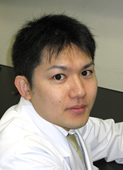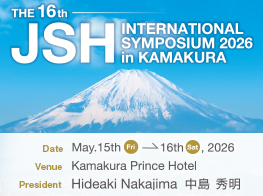
名前:片岡 圭亮 【京都大学大学院医学研究科腫瘍生物学】
発表日時:2015年6月13日
発表形式:口演
Title:
The landscape of somatic alterations in adult T-cell leukemia/lymphoma
Authors:
Keisuke Kataoka1, Yasunobu Nagata1, Akira Kitanaka2, Yasushi Totoki3, Jun-ichirou Yasunaga4, Shinichi Kotani1, Aiko Sato-Otsubo1, Masashi Sanada1, Yuichi Shiraishi5, Teppei Shimamura5, Kenichi Chiba5, Hiroko Tanaka6, Hiromichi Suzuki1, Yusuke Sato1, Yusuke Shiozawa1, Tetsuichi Yoshizato1, Ayana Kon1, Kenichi Yoshida1, Wataru Munakata7, Hiromi Nakamura3, Natsuko Hama3, Kotaro Shide2, Yoko Kubuki2, Tomonari Hidaka2, Takuro Kameda2, Ken Ishiyama8, Shuichi Miyawaki9, Hidehiro Itonaga10, Yoshitaka Imaizumi11, Yasushi Miyazaki11, Masakatsu Hishizawa12, Akifumi Takaori-Kondo12, Ryohei Ishii13, Osamu Nureki13, Genta Nagae14, Hiroyuki Aburatani14, Satoru Miyano5,6, Toshiki Watanabe15, Masao Matsuoka4, Tatsuhiro Shibata3, Kazuya Shimoda2, and Seishi Ogawa1
Affiliations:
1Department of Pathology and Tumor Biology, Graduate School of Medicine, Kyoto University, Kyoto, Japan;
2Department of Gastroenterology and Hematology, Faculty of Medicine, University of Miyazaki, Miyazaki, Japan;
3Division of Cancer Genomics, National Cancer Center Research Institute, Tokyo, Japan;
4Laboratory of Virus Control, Institute for Virus Research, Kyoto University, Kyoto, Japan;
5Laboratory of DNA Information Analysis, Human Genome Center, Institute of Medical Science, The University of Tokyo, Tokyo, Japan;
6Laboratory of Sequence Analysis, Human Genome Center, Institute of Medical Science, The University of Tokyo, Tokyo, Japan;
7Department of Hematology, National Cancer Center Hospital, Tokyo, Japan;
8Department of Hematology and Oncology, Kanazawa University Hospital, Kanazawa, Japan;
9Division of Hematology, Department of Internal Medicine, Tokyo Metropolitan Ohtsuka Hospital, Tokyo, Japan;
10Department of Hematology, Sasebo City General Hospital, Sasebo, Japan;
11Department of Hematology, Atomic Bomb Disease and Hibakusya Medicine Unit, Atomic Bomb Disease Institute, Nagasaki University Graduate School of Biomedical Sciences, Nagasaki, Japan;
12Department of Hematology and Oncology, Graduate School of Medicine, Kyoto University, Kyoto, Japan;
13Department of Biophysics and Biochemistry, Graduate School of Science, The University of Tokyo, Tokyo, Japan;
14Genome Science Division, Research Center for Advanced Science and Technology, The University of Tokyo, Tokyo, Japan;
15Graduate School of Frontier Sciences, The University of Tokyo, Tokyo, Japan
Abstract:
Background
Adult T-cell leukemia/lymphoma (ATL) is one of the most aggressive peripheral T-cell malignancies, which is etiologically associated with human T-cell leukemia virus type 1 (HTLV-1) infection. Although HTLV-1 can effectively immortalize infected T cells, there is a long latency period of 30~50 years before the onset of ATL, suggesting that HTLV-1 infection alone may be insufficient for the development of ATL, but additional genetic lesions that accumulate during the later life are essential. However, such somatic alterations underlying the pathogenesis of ATL remain elusive.
Aims and Methods
To elucidate the landscape of genetic alterations in ATL, we performed an integrated molecular study, in which whole-genome/exome and transcriptome sequencing were performed together with array-based methylation and genomic copy number analysis among a cohort of 81 paired ATL samples, followed by extensive validation using targeted capture sequencing of detected mutations in 370 follow-up samples.
Results
Compared with other hematologic malignancies, ATL cells harbored higher numbers of sequence mutations, copy number alterations, and structural variants, suggesting the presence of global genomic instability in ATL. In addition to previously reported mutational targets in ATL (TP53, FAS, and CCR4) and known targets frequently mutated in other lymphoid malignancies (CARD11, GATA3, IRF4, POT1, CD58, STAT3 and RHOA), we identified a variety of recurrent mutations affecting previously unknown mutational targets, many of which are involved in development, activation and migration of T-cells, immune surveillance, transcriptional regulation, and histone modification. Molecular and functional analysis using human cell lines showed that some of these novel mutations actually enhance T-cell function, validating their biological significance in ATL. A comparison of mutations among disease subtypes revealed several subtype-specific mutations, including TP53 and IRF4 mutations in acute and lymphoma types, and STAT3 mutation in chronic and smoldering types, suggesting that there is a difference in the underlying oncogenic mechanisms between indolent and aggressive forms. Moreover, several mutations, including those in TP53, IRF4 and CCR4, independently predicted worse clinical outcomes. ATL cells showed a distinct pattern of copy number changes and genomic rearrangements. Interestingly, their gene targets showed a significant overlap to mutational targets. Intriguingly, somatic focal deletions involving the 14q31.1 locus were observed in all the cases examined by whole-genome sequencing and therefore are thought to characterize ATL genomes, although their gene targets remained to be identified. Conspicuously, pathway analysis demonstrated that multiple genes involved in the Tax interactome were systematically altered in ATL, although Tax itself underwent gene silencing in most cases. These data suggested that ATL cells can escape from immune surveillance by silencing immunogenic Tax expression, while developing alternative oncogenic mechanisms through acquiring somatic mutations or copy number alterations in the Tax-related pathway.
Conclusion
Our findings suggest that the deregulation of T-cell functionalities caused by genetic alterations, especially those related with HTLV-1 Tax oncoprotein, are pivotal to ATL pathogenesis, and provide a novel clue to contrive new diagnostics and therapeutics to combat this intractable disease.
EHA2015参加レポート
この度は、20th Congress of European Hematology Association(EHA)で発表するにあたり、日本血液学会EHA Travel Awardに採択していただき、誠にありがとうございました。 学会は2015年6月11日から14日までオーストリアのウィーンで開催されました。会場はReed Messe Wienで、ウィーンの歴史的な建造物の中では、ひときわ目立つ近代的な会議センターでした。EHAはヨーロッパ各地だけでなく、米国やアジア、オーストラリア、さらにはアフリカや南米など世界各地から参加者が集まっていました。その多くの参加者が、臨床研究や基礎研究などのそれぞれの分野で積極的に広く意見交換をしており、大変な活気が感じられました。会場自体はとても大きな建物でしたが、会場内の各部屋は比較的コンパクトにまとまっており、セッション間も余裕を持って移動することが出来ました。
私は今回、成人T細胞白血病リンパ腫(adult T-cell leukemia/lymphoma)における網羅的な遺伝子解析の結果について発表させていただきました。ATLはhuman T-cell leukemia virus type 1を原因とする予後不良のT細胞リンパ腫で、日本に特に多いとされている疾患です。私どもは全エクソン解析・全ゲノム解析・トランスクリプトーム解析・メチル化アレイ・SNPアレイなど様々な手法を駆使して、400例以上という多数の症例を対象としてATLのゲノム異常の解析を行いました。その結果、既知の遺伝子異常以外に、新規の繰り返し起こる遺伝子変異やコピー数異常、融合遺伝子を同定しました。これらの遺伝子異常の中には、ATLの病型に特徴的な異常も含まれており、一部の遺伝子変異は有意にATL患者の予後と相関することも明らかにしました。これらの結果は、今後ATLの新規の診断や治療を開発するにあたり極めて重要な知見になると考えられます。
今回の学会では、基礎研究に関する発表を中心に聴講しましたが、特に印象的であったものとしては、Presidential Symposiumで発表された急性骨髄性白血病の化学療法後再発に関係する微小残存病変とDNMT3A R882変異が関係すること、およびこの変異が化学療法抵抗性をもたらす機序が明らかにされた報告です。Olga Guryanova博士は、患者検体を用いてDNMT3A R882変異が微小残存病変と関係することを示すと同時に、遺伝子改変マウスモデルにおいて他の遺伝子変異と組み合わせることにより白血病モデルを再現し、さらにDNMT3A R882変異によりDNA傷害センシング機構が機能不全を起こすことにより、化学療法抵抗性が獲得されることを示しました。私たちのグループでも、様々な造血器腫瘍の遺伝子変異の検索を行ってきましたが、これまでの遺伝子変異を発見することから、発見された遺伝子変異の臨床的な意義やその分子機序を解明することが重要になっていると改めて感じました。
最後になりますが、このような貴重な機会を与えてくださった日本血液学会事務局および国際委員会の諸先生方、日頃よりご指導頂いている京都大学腫瘍生物学の小川誠司教授、本研究に関わった全ての皆様に心より感謝申し上げます。



